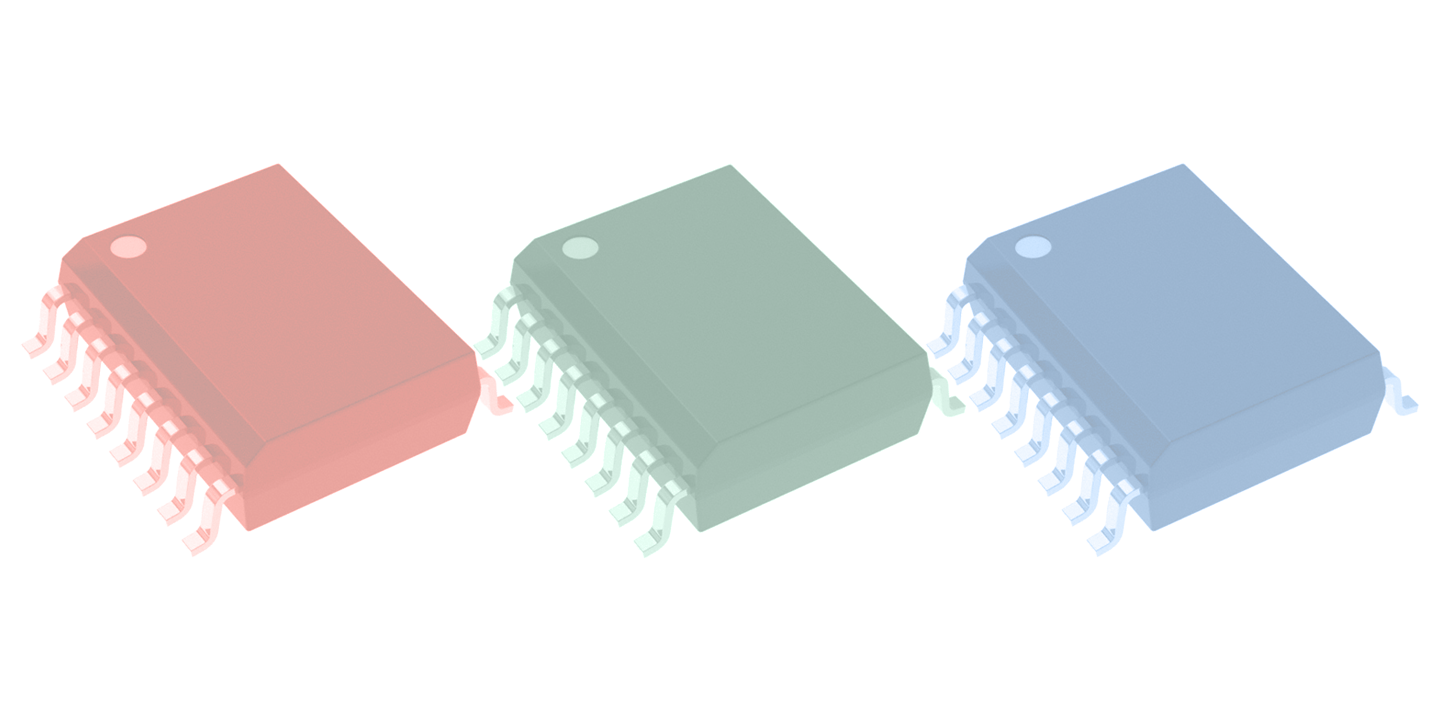
Imagine if the electronics in your car needed a pair of wires to connect with each other. Cable assemblies in cars are already staggering, but CAN bus is one of the protocols that helps decrease the bus width and wire count. Although originally adopted by large manufacturers rather than the automotive industry, the CAN bus remains an important part of the automotive landscape and finds uses in areas like building automation.
In essence, any system that requires connecting multiple devices on a single serial bus that can stretch a long distance can make use of CAN bus. The enabling component is a special transceiver that provides logic signals to the rest of the bus. Industrial, automotive, robotics, and similar applications may require an isolated CAN transceiver, depending on the location of the end subsystem. Here’s when you’ll need to use an isolated CAN transceiver and example components you’ll find on the market.
Making Sense of CAN Bus
The controller area network (CAN) bus was originally developed by Bosch and was eventually codified in the ISO 11898 standards. This architecture is quite simple, although data frame construction can be difficult for a first-timer. Each device on the bus uses a transceiver, which then transmits and receives messages to/from every other device’s transceiver on the bus. A basic identification feature ensures only the desired node on the network actually processes the received data. The structure of a typical CAN bus is shown below.

CAN bus architecture with a transceiver on each node.
Standard features that are used in the CAN bus protocol are a range of data rates, error handling, collision detection, and fault tolerance. In this bus, we have a two-wire system that can span long distances, depending on data rate. The data rates and maximum distances defined in the CAN standards is shown below. Note that the last entry is defined in the CAN FD specification (ISO 11898-2); this standard allows more data to be packed into a single frame (64 bytes vs. 8 bytes for classical CAN).
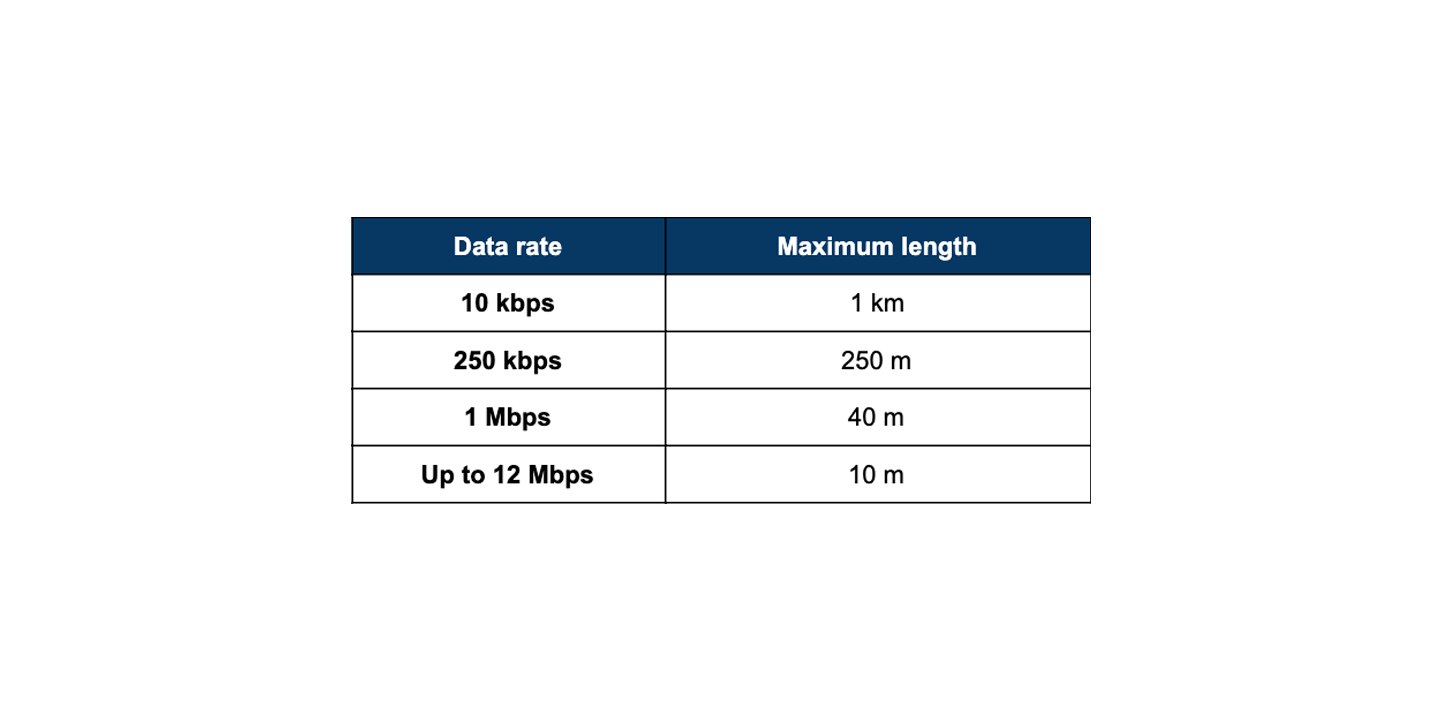
Some original applications in industrial control and communication likely involved working near high voltage sources, thus isolation is required to protect system components. Rather than using an external transformer to cancel common-mode transients, you can use a CAN transceiver IC.
Why Use an Isolated CAN Transceiver?
An isolated CAN transceiver IC integrates the standard features required to interface with a CAN bus while ensuring high galvanic isolation. As applications like automotive, aerospace, and a range of industrial applications require working near high voltage source or possible power surges, isolated CAN transceivers are ideal for ensuring reliability.
Because you’ll need to balance galvanic isolation with data rate and other integrated features, pay attention to these important specifications:
Isolation ratings. Isolation is the primary reason these types of transceivers are used, and their ESD ratings are important for ensuring safety and compatibility with other products and specific applications. This is normally stated as an RMS value in the kV range.
Fault voltage. Electrical faults can occur on the bus, rather than being induced by an external power source. The fault voltage is typically several dozen V for high quality components.
Temperature rating. Since CAN buses are normally deployed in harsher environments, they may carry a high temperature requirement. Be sure to check this in your component datasheets.
Standards compliance. Like many power management components, datasheets for isolated CAN transceivers may contain compliance statements. UL 1577 is one common standard, but IEC standards or ISO standards may be listed if the transceiver is targeting specific applications.
Here are some of the common CAN transceiver ICs you’ll find from component manufacturers and distributors.
Texas Instruments, ISO1042QDWRQ1
The ISO1042QDWRQ1 isolated CAN transceiver from Texas Instruments provides flexible data rate (classic CAN up to 1 Mbps and CAN FD up to 5 Mbps). This transceiver supports up to +/- 30 V common-mode voltage range with up to 70 V of fault protection. It also supports a variety of logic interfaces to a standard CAN controller. Galvanic isolation is guaranteed up to 5 kV (RMS) with 100 kV/µs CMTI and 1060 V RMS working voltage.
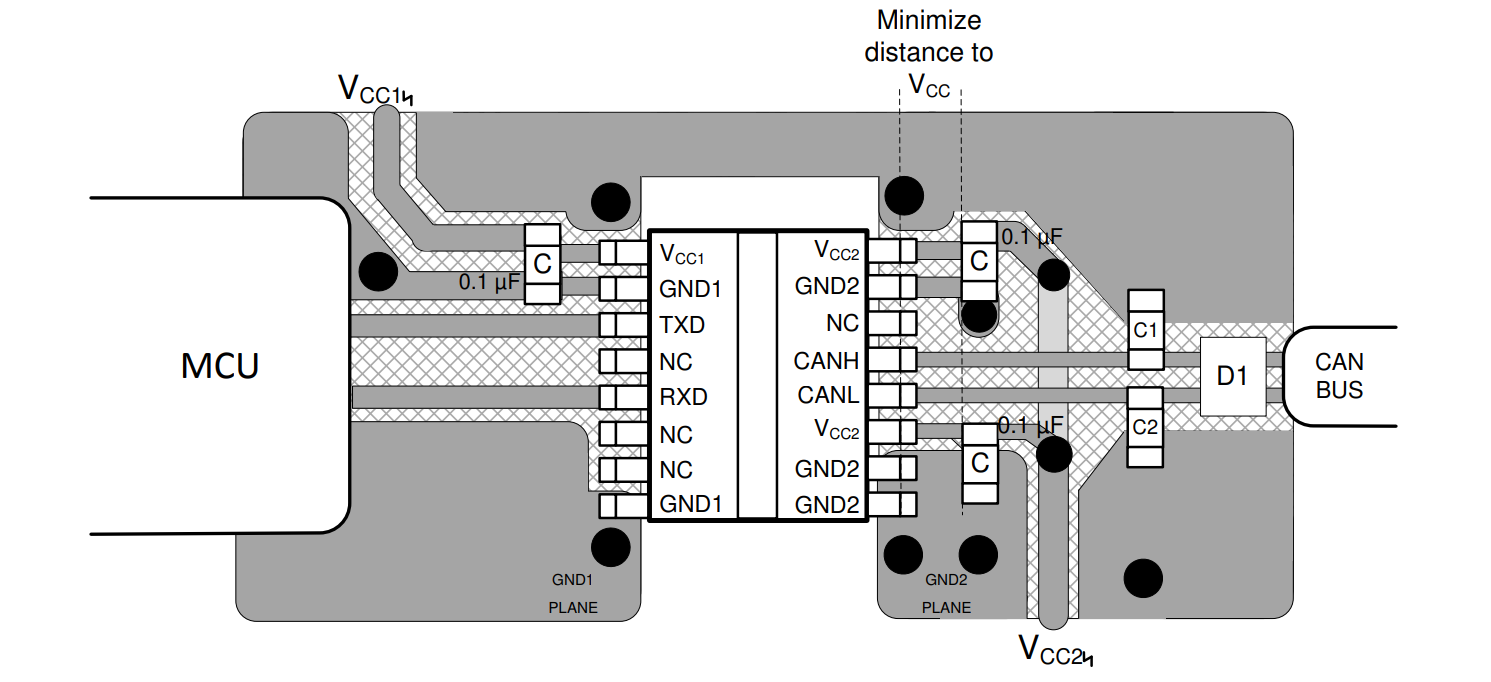
Recommended layout for the ISO1042QDWRQ1 isolated CAN transceiver from Texas Instruments. From the ISO1042QDWRQ1 datasheet
Maxim Integrated, MAX14882
This MAX14882 from Maxim Integrated operates at up to 1 Mbps and provides up to 5 kV (RMS) of galvanic isolation for 60 s with 848 V (RMS) continuous working voltage. The integrated LDO accepts a broad voltage range for the supply interface, and this transceiver is fault-tolerant up to 54 V. This component is also compliant with the UL 1577 standard for basic insulation and cUL (CSA Bulletin 5A). Ideal applications include building controls, industrial control, and HVAC.
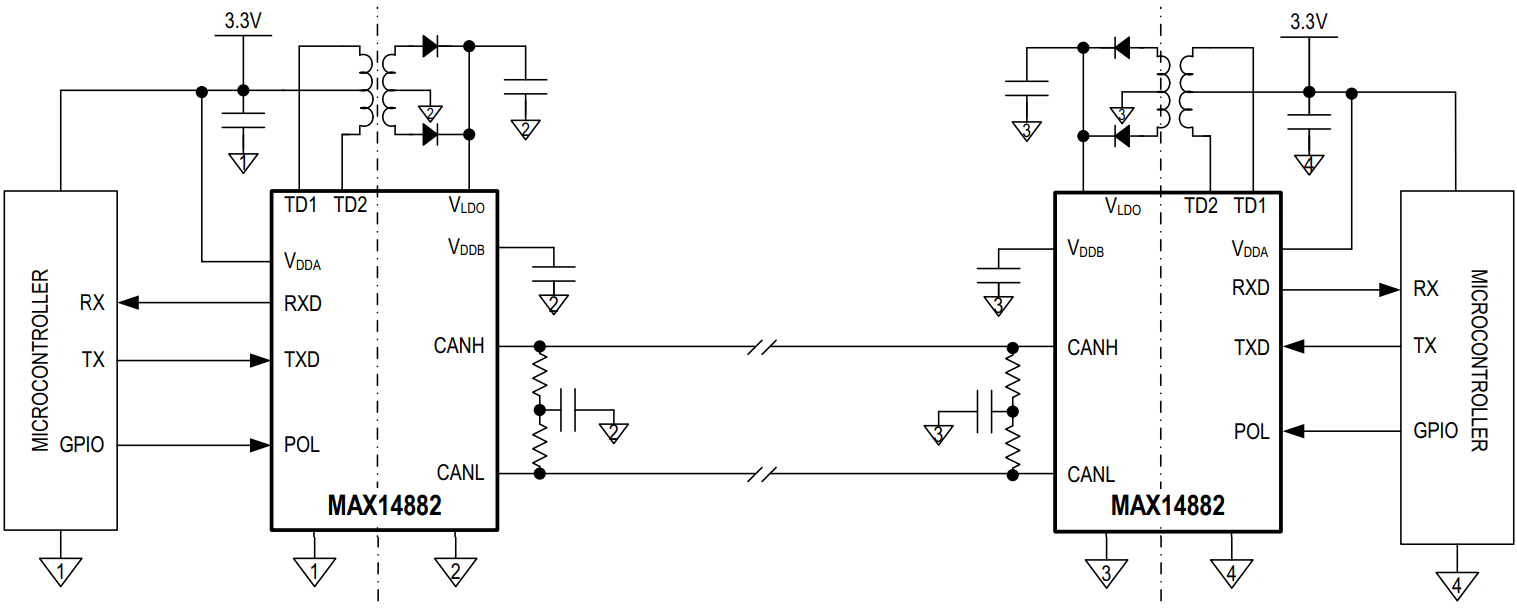
Typical MAX14882 application circuit with split termination. From the MAX14882 datasheet.
NXP Semiconductors, TJA1052IT
The TJA1052IT series from NXP Semiconductors is specifically targeted at electric vehicles, which require high galvanic isolation between high and low voltage subsystems. This component provides up to 5 Mbps data rate and can be used in 12 and 24 V systems. In addition to providing high isolation up to 5 kV, this IC is compliant with UL 1577, IEC 61010, IEC 60950, and ISO6469. Variants in this series provide isolation up to 1 kV, 2 kV, or 5 kV.
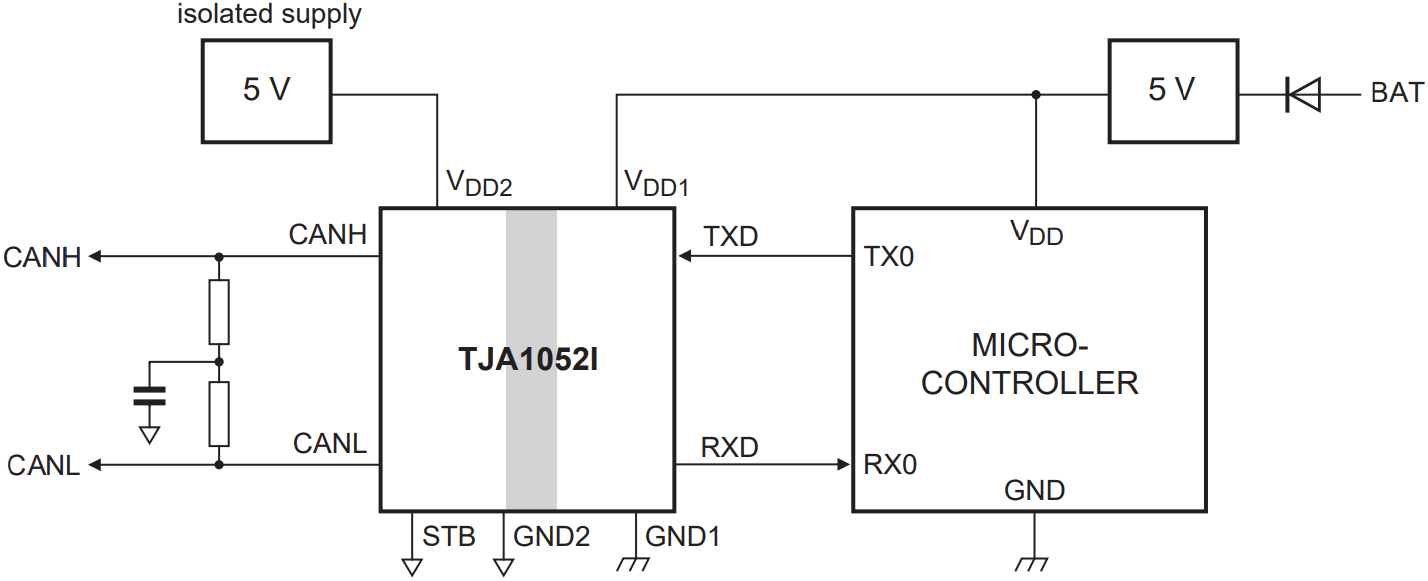
Application circuit for the TJA1052IT isolated CAN transceiver. From the TJA1052IT datasheet.
Other Components for Isolation and Communication
The components presented here are just a few options, but they represent the top-of-the-line components that designers need for many applications. In addition to these components, there are other parts you might need for your next CAN bus-capable system.
Even after you select common-mode choke components and other filters for your system, you’ll likely need a range of components for managing power distribution in your power supply. Here are some other common components needed for high voltage/current systems:
No matter which type of system you’re designing, you can find the components you need to place and route digital bus protocols using the advanced search and filtration features in Octopart. The comprehensive manufacturer and distributor dataset from Octopart, as well as a user-friendly interface to help you find a huge range of isolated CAN transceiver ICs. Take a look at our integrated circuits page to find the components you’ll need for data transmission and management.
Stay up-to-date with our latest articles by signing up for our newsletter.